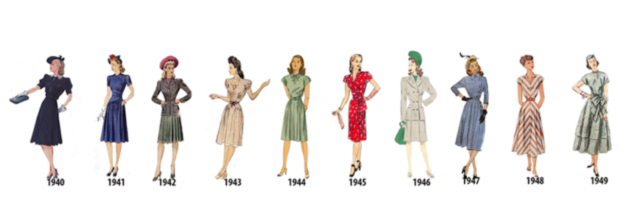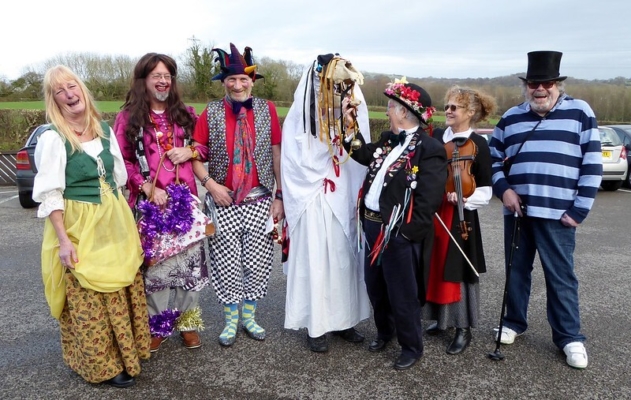The 1940s and the explosion of female fashion
In this blog, we are moving on to look at the fashions associated with the 1940s. Unlike during the first world war, when fashion development slowed down, female fashion developed rapidly during the second world war. Men’s fashion coincidentally did not change much at all.
International Fashion in the Forties
There were many glamourous female figures who showcased these fashion trends, such as Ava Gardner, Bette Davis, Rita Hayworth, Grace Kelly, Ingrid Bergman, Katharine Hepburn and Doris Day. They particularly highlighted the American trends, but Britain developed its own style.

Ava Gardner (Flickr, Lexinatrix)
The development of British fashion mainly occurred because the French fashion houses were inaccessible to Britain under the German occupation of France. The French fashion houses kept going because if they closed down they could be taken over by the Germans. But they were only able to sell their clothes to the Germans.
Utilitarian fashion designers
At the start of the second world war, strict rationing on fabric was introduced. Clothing had to be bought with rationing coupons. What made this such a success was that the British Government got leading London designers involved with creating the clothes for people to buy.
What this effectively meant was that everyone wore a very similar style and it was all based on designs by the leading Saville Row fashion designers of the time. These were people such as Norman Hartnell (who designed Princess Elizabeth’s wedding dress for her marriage to Lieutenant Philip Mountbatten in 1947), Hardy Amies and Edward Molyneux.

The designs were submitted through the Incorporated Society of London Fashion Designers (also known as Inc. Soc.). The clothes the designers came up with were utilitarian pieces, known as Utility clothing, with bright colours. This is not always obvious from the black and white pictures of the time (see above) but the clothes were often in rich blues, pinks, yellows and greens.
The clothes were a simpler and more democratic approach to fashion. They were meant to last for years (which is why there is a market in ‘retro 1940s clothes’ and they can still be bought secondhand and worn). They were high-quality and very well-made despite the rationing. A British Utility dress could be bought for 7 coupons.

Changes in dress design
The dresses of the 1940s were shorter: knee-length instead of the mid-calf length of the 1930s. They created a much more masculine appearance but with an hourglass silhouette. The details included:
- shoulder pads (extending just past the edge of the shoulder);
- puffed sleeves, gathered at the top, extending down to approximately the elbow;
- boxy/square neck-line/shoulder angle;
- nipped-in high waist; and
- knee-length A-line skirts.
These features appeared in the shaping of all suit jackets, blouses and dresses.
The exception to this was the evening dress, which was either spaghetti-strapped or halter topped and revealed the chest and shoulders (with mild amounts of cleavage on show). The skirts of these dresses started long and sleek, but were much fuller by the end of the decade.

Alla modelling a dress from Galitzine's collection at her showroom. (Kristine, Flickr)
The introduction of trousers into mainstream feminine fashion
Up until the 1940s trousers had been mainly worn by men. However, when they started working in the factories women needed clothing that was safe to wear around machinery and that would not get caught in the moving parts.
To start with women wore men’s trousers, but fairly quickly manufacturers started making trousers specifically for women. The design still looked masculine, but it was also:
high-waisted;
- fastened with a button or zip down the side;
- wide-legged with wide cuffs at the bottom; and
- made out of cotton, denim or wool blends.
Trousers soon became homeware as casual clothes and were acceptable for a woman to wear in public.
Suited to work
Due to the shortage of fabric, the popularity of two-piece suits increased. These suits were popular because the skirts, jackets and blouses could be mixed up, they did not need to match. Women could therefore have a ‘new’ suit to wear every day using the same clothes. This type of suit was called the Victory or Utility Suit.
After the war, these suits remained popular because they were comfortable and practical to wear. The skirts of the suits were A-line meaning they flared out gradually from the hip to the knee. In the early 1940s, there were no pleats or gatherings to the skirts because of fabric rationing. Later in the decade, pleats started to appear and a wider A-shape. Some skirts even had pockets!

The suit jackets were made from the same material as the skirts but they could also be mismatched. As with the dresses, the jackets had wide, padded shoulders, a high neckline and a nipped-in waist, that flared out slightly at the bottom. The lower edge of the jacket reached down to the mid-hip. They were worn buttoned with variation in lapel widths, some had points or were shaped. It was not necessary to wear a blouse underneath the jacket but it was more comfortable to do so.
A different style of jacket was the Bolero jacket. This was shorter with a rounded edge and long, narrow sleeves. It was worn over a blouse and rarely buttoned-up at the front. Leaving it to hang open showed off the blouse.
Blouses were either worn plain or with a light cardigan or jacket. They could be a solid colour or have a fun, striped pattern. They were either short or long-sleeved with puffy gathers and tight cuffs. They had buttons at the front and either small v-necks or a round collar neck opening.
A Swimming Success
Swimsuits in the 1940s were either one or two-piece affairs. The one-piece had a tighter fit than swimsuits in the 1930s. It also had a padded bra for support and either thin shoulder straps or a halter. The neckline was in the shape of a ‘v’ but with little cleavage on show. The halter-style was particularly popular. The bottom of the swimsuit came down to the top of the thigh and was either skirt-shaped or was in the form of slightly looser shorts.
The two-piece swimsuit was like the one-piece suit but with the middle section removed so the shorts came up over the belly-button leaving a 4-inch space between the top and bottom piece. The Bikini was invented in 1946 and was a similar style but tighter with a lower waist. These were too revealing for most women at this time. Incidentally, the word ‘bikini’ comes from the Bikini Atoll where the USA detonated two nuclear bombs in 1946.

Three young women on a beach in swimwear, mid 1940s (Family photos of Infrogmation" CC BY 2.5, Wikimedia Commons
Another popular item of holiday clothing was the playsuit. This was a beachwear dress for wearing over a swimsuit. It was a buttoned, loose-fitting, light, cotton dress. Some also had high-waisted shorts or a swimsuit halter top. These were popular with teenagers and younger, single women.
Fashion for a distinguished age
It was in the 1940s that plus-sized clothing also developed. Catalogues and department stores developed ‘stout’ clothing ranges for the more mature women. These ranges included dresses, tops, coats and shoes. They were designed to be more flattering to the fuller figure, which was not really suited to the hourglass style. There were also longer beachwear ranges that were more conservative for older women.

After the war, and Christian Dior
In the late 1940s rationing ended, and there was more fabric and more choice available. This was quickly taken up and designs became more colourful with patterns and contrasting trims. A newly invented fabric called rayon was introduced. Teenagers were particularly fans of the skirts which came in a range of designs – plaids, stripes or the latest style. These were easier to move in and so were good for swing dancing.
In 1947 Christian Dior launched his “New Look” fashion line. The “Corolle” line was the main range in this style. It had rounded shoulders, a cinched-in waist and a long, full skirt. At the time it received a mixed reaction: after the war, some people thought it was wasteful (the “Cherie” dress had lots of tight-pleating), others felt it was a setback in the progress of women’s clothing because it was so blatantly feminine. But it became, and remained, popular.
The post-war relaxation away from utilitarian fashion continues in our next instalment in the series, where we take a look at the fashions receding hemlines of the 1950s.










